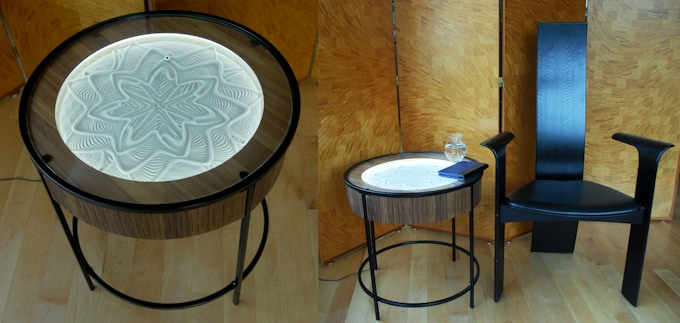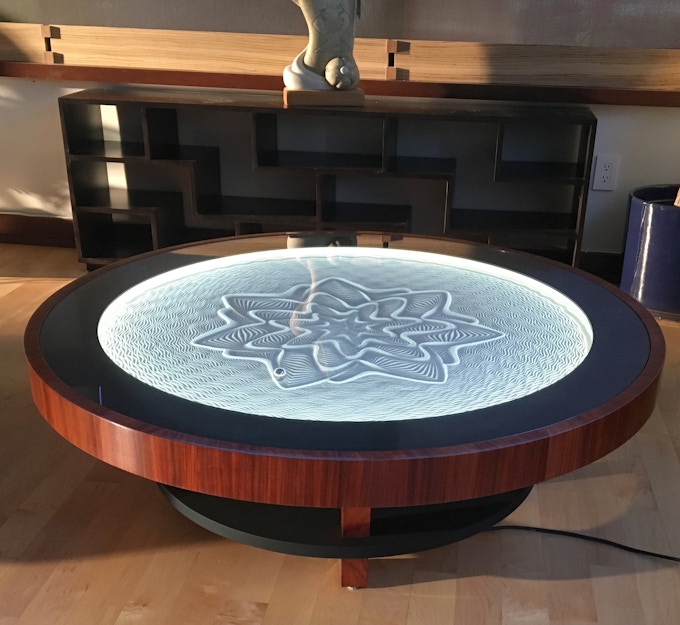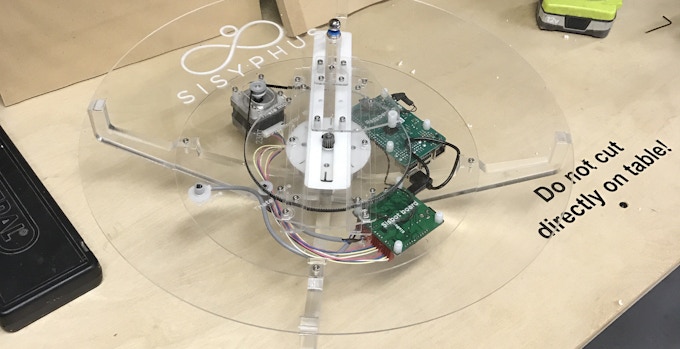
What is Sisyphus?
In Greek mythology, Sisyphus was condemned to roll a boulder up a mountain for all eternity. In my art, Sisyphus is a kinetic sculpture that rolls a ball through sand, forever creating and erasing beautiful patterns. Watching Sisyphus evokes a meditative feeling.
I have been creating Sisyphus sculptures for nearly 20 years, and have large, 3-meter diameter permanent installations in Switzerland, Germany and Australia. Over time I have come to view Sisyphus as more than a kinetic art piece: it is an instrument. As a musical instrument plays songs, Sisyphus plays paths. My goal with this Kickstarter is to get Sisyphus into people’s homes for them to enjoy as both furniture and art, but also, to inspire a community of composers to write “music” for it.

End Table: Sisyphus kinetic sculpture within 2 foot diameter x 22″ tall, tempered glass-topped metal table (exact size may vary). Stepper motor driven Sisbot mechanism. Metal furniture with wood veneer options for top and sides – birch/maple, walnut, black. Some assembly required.

3 foot coffee table: Sisyphus kinetic sculpture within 3 foot diameter x 18″ tall, tempered glass-topped metal table (exact size may vary). Stepper motor driven Sisbot mechanism. Metal furniture with wood veneer options for top and sides – birch/maple, walnut, black. Some assembly required.

Hardwood coffee table: Sisyphus kinetic sculpture within 4 foot diameter x 18″ tall, tempered glass-topped metal table. Brushless servo driven Sisbot mechanism. ApplePly base and choice of hardwood furniture – maple, walnut, padauk – all CNC machined and hand finished. All components including servo motors made in the U.S. except circuit boards.
Shipping is included in the continental US.


The journey:
My journey as an artist began, appropriately enough, with an egg (Eggbot). 25 years ago I quit my job as a doctor to follow my passion: using computer-controlled machines to create art. I discovered that industrial giants like 3M and Honeywell sold their used industrial equipment cheaply on the local surplus market, allowing me access to uber-expensive automation components at pennies on the dollar. Where the companies had seen tools for mass producing floppy disks and sticky notes, I saw a new artistic medium. In 1995, I registered my website: “The Art of Motion Control.” My friends and family thought I was crazy (and I was) but my wife Beverly supported me, and I went on to create widely varied pieces involving metal, flying silk ribbons, and even bubbles. But of all works I made, Sisyphus stood out – it was my first CNC machine to break out of the studio/shop. No longer tasked with cutting materials to be used in making sculpture, it was the sculpture itself. It was also unique in another way – I wanted to live with it in my home. And so I’ve spent the last three years perfecting a home version that is beautiful, user-friendly, and that is near-silent and will run for years.
I owe a great deal to the Maker Movement for helping along the way. I was building DIY CNC machines well before Make Magazine first published in 2005, but it was my time at a new makerspace in Minneapolis six years ago that made it possible to push further than I could ever have gone on my own. It was there that I first got to use truly reliable CNC tools, spending my time making instead of fixing. It was there that I learned to value the cross-pollination of ideas that happens in makerspaces. And it was there that I met Micah Roth– a tall, lanky, quiet dude, with a wry smile – who could make, fix, and figure out just about anything he set his mind to. After only one year, that space folded. Six members, including Micah and myself, set off and started our own – Nordeast Makers. Now three years old, NEM is thriving, and will serve as the center of production for Sisyphus. And Micah, who keeps NEM humming, has joined my wife and me on the Sisyphus project team.

How does it work? (simple version)
What you see is a fully functional table with a thin layer of sand under its glass top. Under the table is a two-motor robot (the “Sisbot“) that moves a magnet which draws a steel ball through the sand. The motors are controlled by a small Raspberry Pi computer which plays a set of path files, much like a music player plays an mp3 file. Sisyphus has no on/off switch; you simply plug it in and it automatically calibrates itself, loads a default playlist of paths, and begins playing. You can control playback – choosing favorite tracks or playlists – speed of play, and table-lighting from a mobile app or by using any browser to connect to Sisyphus with WiFi.

How it works (Technical Details)
Hardware overview – All Sisbots are two axis, polar plotters. The smaller versions (for sand fields < 40″ diameter) are stepper-actuated, using Trinamic drivers. Brushless servomotors / drives are used for larger versions. Hi level control is done by using code written in NodeJS, running on a Raspberry Pi 3. This includes both high-level motion control routines, file handling, and serving a two-way WiFi interface. Low-level motion control is handled by the SisBotBoard (SBB), designed by embedded systems engineer Brian Schmalz (designer of the EiBotBoard (EBB) for Eggbot). Point-to-point commands are streamed from the Pi to the SBB over serial USB, and the SBB does the low-level timed generation of step / direction signals that govern the motors. Software dimmable white LED lighting surrounds the sandfield. Power is provided by a 12VDC supply for both the LED’s and Sisbot. A single AC power cord plugs in to a standard outlet (total power consumption <100W for smaller tables, <200W for 4-foot table).
Software overview – At the lowest level, the SBB runs a custom version of the EBB firmware, and conforms to the EBB command syntax. NodeJS code on the RPi will be freely upgradable, as it evolves. Routines for converting standard vector file formats (AI and DXF) will be freely downloadable. Algorithmic tools for composing paths are under development.
The Sisyphus path-file format consists of a text file, containing an ordered list of 2-axis vertices, with each line containing the polar coordinates of a point on the unit circle. Paths saved in this format will play on any size Sisyphus (they are scaled appropriately by the software). Designs can be easily translated from traditional Cartesian x-y coordinates.
Interview of me talking about my work with Cool Hunting, in 2007:


Constructing Sisyphus hardwood furniture at Nordeast Makers:

Gluing up a 32-sided padauk hoop



machining the base

——————-
Giant THANK YOU’s to:
Geoff George and Martin Alexander at R62pictures.com for our video,
Dana Woodman and Alex Wayne at BuiltByBig.com for our app,
Brian Schmalz at Schmalzhaus.com for our circuit board and embedded guruhood,
Mike Lindemuth – video footage,
Jeff Lieberman, for last-minute help,
Our two kids, Casey Trombley-Shapiro Jonas, and Ben Trombley-Shapiro, for their support and major editing!
And lastly, to Micah for his friendship and hard work, and Bev, without whom I’d be lost.

See Bruce’s other artwork at http://www.taomc.com/


SOURCE : Kickstarter
